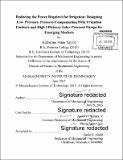| dc.contributor.advisor | Amos G. Winter, V. | en_US |
| dc.contributor.author | Taylor, Katherine Anne | en_US |
| dc.contributor.other | Massachusetts Institute of Technology. Department of Mechanical Engineering. | en_US |
| dc.date.accessioned | 2015-12-16T16:33:39Z | |
| dc.date.available | 2015-12-16T16:33:39Z | |
| dc.date.copyright | 2015 | en_US |
| dc.date.issued | 2015 | en_US |
| dc.identifier.uri | http://hdl.handle.net/1721.1/100350 | |
| dc.description | Thesis: S.M., Massachusetts Institute of Technology, Department of Mechanical Engineering, 2015. | en_US |
| dc.description | Cataloged from PDF version of thesis. | en_US |
| dc.description | Includes bibliographical references (pages 81-86). | en_US |
| dc.description.abstract | This thesis presents a mathematical model investigating the physics behind pressure compensating (PC) drip irrigation emitters and a design of a highly efficient solar powered centrifugal pump for small-acreage farmers drawing from shallow groundwater. The global community is facing a worsening crisis with regards to the water-energy agriculture nexus. Irrigation is a proven way to increase the agricultural productivity of a plot of land; however, with a growing population, it will be necessary to invest in methods of irrigation that are both energy- and water-efficient, and intensify the agricultural output per unit of land. Drip irrigation, a method of irrigation where water is delivered directly to the plant roots through a network of tubes and valves, is a highly water-efficient method that gives high yield per unit area. The current challenge to adoption facing drip irrigation is the high capital and operating costs. It is possible to cut these costs by developing a valve, called an emitter, that gives the desired flow rate at a lower pressure. This lower pressure in turn requires less energy from the pump, allowing for a smaller and less expensive pump, and even making a solar-powered system affordable for small-acreage farmers. In coming decades, it will become increasingly necessary to switch from fossil-fuel based energy to renewables, such as solar. For small acreage farmers in the developing world, this switch will not only alleviate the pains of paying the recurring and volatile costs for diesel fuel, it will also help to lighten the load on the electrical grid by those using electric pumps. | en_US |
| dc.description.statementofresponsibility | by Katherine Anne Taylor. | en_US |
| dc.format.extent | 101 pages | en_US |
| dc.language.iso | eng | en_US |
| dc.publisher | Massachusetts Institute of Technology | en_US |
| dc.rights | M.I.T. theses are protected by copyright. They may be viewed from this source for any purpose, but reproduction or distribution in any format is prohibited without written permission. See provided URL for inquiries about permission. | en_US |
| dc.rights.uri | http://dspace.mit.edu/handle/1721.1/7582 | en_US |
| dc.subject | Mechanical Engineering. | en_US |
| dc.title | Reducing the power required for irrigation : designing low-pressure, pressure-compensating drip irrigation emitters and high efficiency solar-powered pumps for emerging markets | en_US |
| dc.type | Thesis | en_US |
| dc.description.degree | S.M. | en_US |
| dc.contributor.department | Massachusetts Institute of Technology. Department of Mechanical Engineering | |
| dc.identifier.oclc | 931080960 | en_US |
